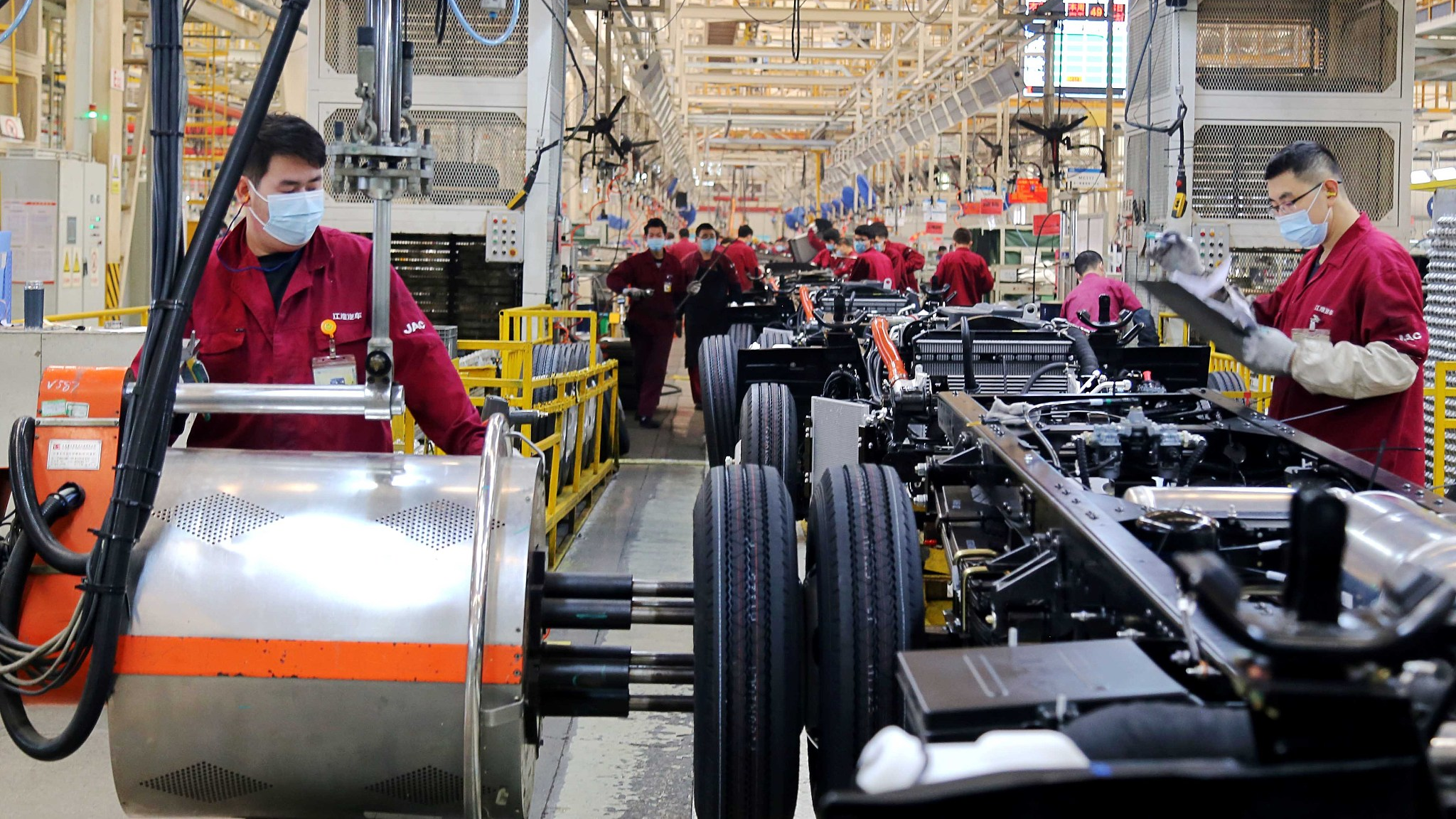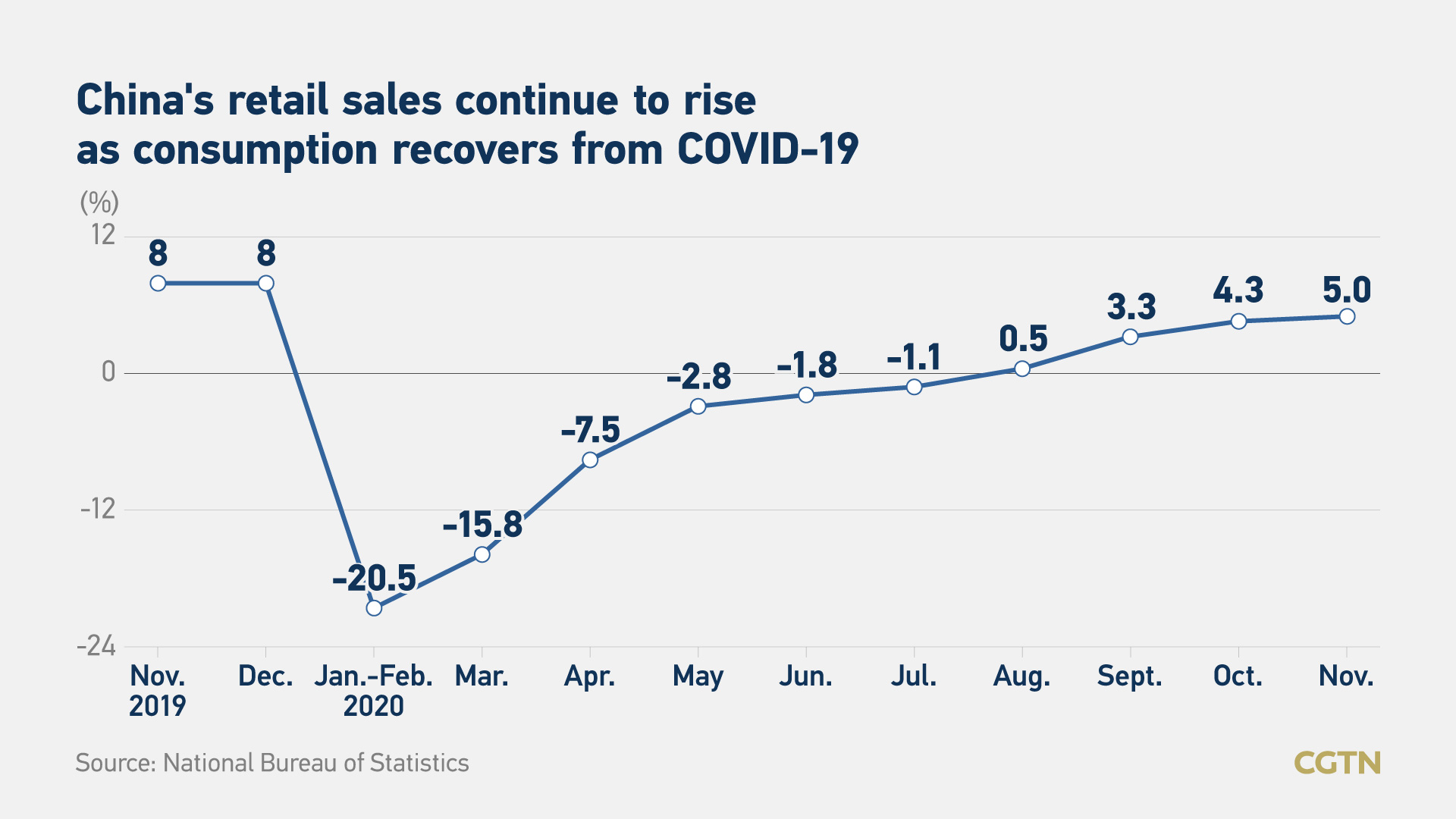02:02

China's industrial production and retail sales kept their steady growth in November as the country's economic recovery strengthened due to strong global demand.
Industrial output climbed 7 percent in November year on year, marking the eighth straight month of expansion, data from the National Statistics Bureau showed on Tuesday. It was in line with Reuters' forecast and higher than the 6.9 percent growth in October.

Graphic by CGTN's Chen Yuyang
Graphic by CGTN's Chen Yuyang
Profits for China's major industrial enterprises, those with an annual business turnover of at least 20 million yuan ($3.05 million) from their primary operations, edged up 0.7 percent in the first 10 months of 2020 to settle at 5.01 trillion yuan from the same period last year, earlier data showed. The cumulative industrial profit growth also sailed into positive territory for the first time in the year.
In October alone, the profits of major industrial enterprises reached 642.91 billion yuan, skyrocketing 28.2 percent from a year earlier.
Jimmy Zhu, a chief strategist at Fullerton Research, told CGTN that the acceleration in factory production growth is accordant with China's expansion in factory activity.
In November, China's manufacturing Purchasing Manager's Index stepped up to 52.1, the fastest pace in over three years, official data showed.
One of the reasons China shows such strong output in its industrial sectors is that "some industrial chains have been transferred to China" during the pandemic.
"China has the ability to produce when other countries' productions are still under the COVID-19 effect," explained Zhu.
Retail sales growth quickened to 5 percent in November from a year earlier, reaching 3.95 trillion yuan, faster than the 4.3 increase in October but 0.2 percent lower than analyst expectations in a Reuters poll.
The breakdown shows that consumption in the countryside grew more rapidly than in urban areas.
Retail sales growth in consumer goods increased to 5.8 percent in November to 3.45 trillion yuan, maintaining a growing trend for five consecutive months.
Online retail sales of physical goods, which account for 25 percent of the total retail sales of consumer goods, increased by 15.7 percent between January and November.
Read more: Double 11 Shopping Festival: $56 billion sales boom demonstrates China's sustainable consumption power

Graphic by CGTN's Chen Yuyang
Graphic by CGTN's Chen Yuyang
China's economic recovery has been leading the globe's, as it was the first country to emerge from the shade of the COVID-19 pandemic. The strong demand at home and abroad has driven the Chinese economy further ahead and made it the only major economy to likely see positive growth this year.
Read more: China to be the only economy with positive growth in 2020, says IMF report
The activity readings in November have also signaled an upbeat fourth-quarter performance for the second-largest economy.
"We see some upside risks to our 5.7% year-on-year real GDP growth forecast for Q4," said Lu Ting, chief China economist at Nomura, in a report viewed by CGTN.
Despite the data, Lu expects Beijing to maintain "its current 'wait-and-see' policy approach, as the coronavirus remains an issue."
The country's better-than-expected exports in November surged 21.1 percent year on year to $268 billion, the fastest pace since February 2018, with global markets asking for industrial products and raw materials, according to the General Administration of Customs.
Zhu said China's factory production performance will become more and more related to its trading relationship with Southeast Asian countries.
The Association of Southeast Asian Nations remained China's largest trading partner during the first 11 months, with trade value reaching $610 billion, a year-on-year growth of 5.6 percent.
Fixed-asset investment increased by 2.6 percent from January to November from the same period a year earlier, faster than a 1.8 percent growth in the first 10 months of 2020. Meanwhile, manufacturing fixed-asset investments jumped to 12.5 percent year on year in November alone compared to 3.7 percent in October.
Private-sector fixed-asset investment growth turned positive for the first time with a 0.2 percent rise from January to November, compared with a 0.7 percent decline in the first 10 months of the year.
(Cover image: Workers assemble cars in an automobile manufacturing factory in Qingzhou City, Shandong Province, China. /CFP)

